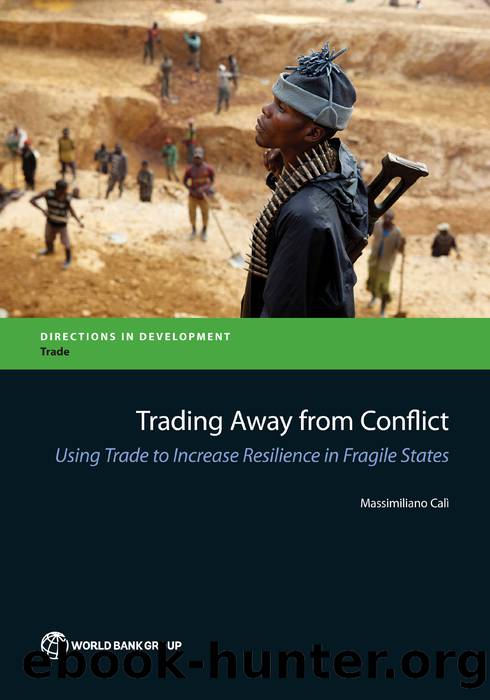Trading Away from Conflict: Using Trade to Increase Resilience in Fragile States by Massimiliano Calì

Author:Massimiliano Calì
Language: eng
Format: epub
Publisher: The World Bank
CHAPTER 2
Conditions That Affect the Impact of Trade Shocks on Conflict
Introduction
Changes in economic activity, including those originating in external trade, do not affect peace and stability in a vacuum. Deep-seated factors, often dating back in history, need to be in place in order to create the conditions for conflict and political instability. Norway, Canada, the Republic of South Sudan, and Nigeria are all oil rich economies, but swings in oil prices have little potential to create instability in the first two countries and a great deal of potential in the last two. Changes that affect trade in goods have different effects across countries even in the same region. Increased diamond production and trade, for example, has been associated with higher levels of conflict in the Central African Republic (International Crisis Group 2010) and in Sierra Leone (Bellows and Miguel 2009), but not in Botswana, where the rents from diamonds were shared across all groups in the society. The widespread perception that this sharing agreement was fair helped ensure stability (Robinson, Acemoglu, and Johnson 2003).
These examples point to a basic but often forgotten principle: the expected effects of changes in trade on instability are likely to differ across countries, and across regions within countries. Various factors are likely to facilitate or hinder the extent to which these changes can create instability. Improving our understanding of how the relationship between conflict and changes in trade differs across contexts is important for at least three reasons. First, it would help identify some of the conditions under which changes in trade are more harmful. This information would be important in developing proper monitoring frameworks for future sharp changes in trade volumes or prices. Second, it would allow policy makers to identify, and possibly address, the conditions that make countries vulnerable to changes in trade flows. And third, it would improve our analysis of the extent to which trade-related changes affect conflict. That is, analysis which bundles together countries with very different conditions may conclude that trade-related changes have no impact on conflict, while actually they may be important for conflict, but only in countries that meet certain conditions.
Unfortunately, our understanding of the conditions under which changes in trade trigger conflict remains limited. Scholars have acknowledged the importance of this heterogeneity. Blattman and Miguel (2010, p. 31) note that âthere is good reason to believe that the relationships between civil conflict and income shocks ⦠should be conditional ones, evident primarily when interacted with other contextual variables.â However, macroeconomic studies of the relationship between trade-related changes and conflict have rarely tested systematically for these conditioning factors, and no consensus has emerged on their effects.
The local conditions that might affect the relationship between changes in trade and conflict include: (a) grievances that foster tensions among groups, for example generated by economic inequality, ethnic and religious differences, and past conflict events; (b) the stateâs institutional capacity and political structure, particularly whether government policies foster inclusiveness; (c) conditions in neighboring countries that might encourage or discourage conflict; and
Download
This site does not store any files on its server. We only index and link to content provided by other sites. Please contact the content providers to delete copyright contents if any and email us, we'll remove relevant links or contents immediately.
International Integration of the Brazilian Economy by Elias C. Grivoyannis(57388)
The Radium Girls by Kate Moore(10915)
Turbulence by E. J. Noyes(7057)
Nudge - Improving Decisions about Health, Wealth, and Happiness by Thaler Sunstein(6642)
The Black Swan by Nassim Nicholas Taleb(6203)
Pioneering Portfolio Management by David F. Swensen(5615)
Rich Dad Poor Dad by Robert T. Kiyosaki(5162)
Zero to One by Peter Thiel(4834)
Man-made Catastrophes and Risk Information Concealment by Dmitry Chernov & Didier Sornette(4748)
Secrecy World by Jake Bernstein(3788)
Millionaire: The Philanderer, Gambler, and Duelist Who Invented Modern Finance by Janet Gleeson(3575)
Skin in the Game by Nassim Nicholas Taleb(3477)
The Age of Surveillance Capitalism by Shoshana Zuboff(3432)
The Money Culture by Michael Lewis(3291)
Skin in the Game: Hidden Asymmetries in Daily Life by Nassim Nicholas Taleb(3271)
Bullshit Jobs by David Graeber(3190)
The Dhandho Investor by Mohnish Pabrai(3175)
The Wisdom of Finance by Mihir Desai(3086)
Blockchain Basics by Daniel Drescher(2895)
